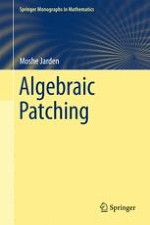2011 | OriginalPaper | Chapter
The Absolute Galois Group of C(t)
Activate our intelligent search to find suitable subject content or patents.
Select sections of text to find matching patents with Artificial Intelligence. powered by
Select sections of text to find additional relevant content using AI-assisted search. powered by
Let
C
be an algebraically closed field of cardinality
m
,
x
an indeterminate,
E
a finite extension of
C
(
x
) of genus
g
, and
S
a set of prime divisors of
E
/
C
. We denote the maximal extension of
E
ramified at most over
S
by
E
S
. If
X
is a smooth projective model of
E
/
C
, then we interpret
S
as a subset of
X
(
C
), call Gal(
E
S
/
E
) the
fundamental group of
X
\
S
, and denote it by
π
1
(
X
\
S
). Starting from the fundamental group of the corresponding Riemann surface and applying the Riemann existence theorem, one proves that when
r
=card(
S
)<∞, Gal(
E
S
/
E
) is the free profinite group generated by
r
+2
g
elements
σ
1
,…,
σ
r
,
τ
1
,
τ
′
1
,…,
τ
g
,
τ
′
g
with the unique defining relation
σ
1
⋅⋅⋅
σ
r
[
τ
1
,
τ
′
1
]⋅⋅⋅[
τ
g
,
τ
′
g
]=1 (Proposition 9.1.2). Using Grothendieck’s specialization theorem, we generalize that result to an arbitrary algebraically closed field
C
of characteristic 0 (Proposition 9.1.5). In particular, if
r
≥1, then
$\mathrm{Gal}(E_{S}/E)\cong \hat{F}_{r+2g-1}$
. When
m
=card(
S
) is infinite, we take the limit on all finite subsets of
S
to conclude that
$\mathrm{Gal}(E_{S}/E)\cong \hat{F}_{m}$
(Corollary 9.1.9). In particular, if
S
is all of the prime divisors of
E
/
C
, then card(
S
)=card(
C
) and we find that
$\mathrm{Gal}(E)\cong \hat{F}_{m}$
(Corollary 9.1.10). In particular, Gal(
E
) is projective (Corollary 9.1.11).
The situation is quite different when char(
C
) is a positive prime number
p
. We can not use the Riemann existence theorem to determine the structure of Gal(
E
S
/
E
). Indeed, if
S
is nonempty and of cardinality less than that of
C
, then Gal(
E
S
/
E
) is even not a free profinite group (Proposition 9.9.4) as is the case in characteristic 0. What we do know is the structure of the Galois group Gal(
E
S
,
p
′
/
E
), where
E
S
,
p
′
is the maximal Galois extension of
E
ramified at most over
S
and of degree not divisible by
p
. Using Grothendieck’s lifting to characteristic 0, one proves that the latter group is just the maximal quotient of order not divisible by
p
of the corresponding group in characteristic 0 (Proposition 9.2.1). But, this does not help us to compute Gal(
E
). Instead, we prove by algebraic means that Gal(
E
) is a free profinite group of cardinality
m
. This proof works over every algebraically closed field and does not use the Riemann existence theorem.
The first step is to prove that Gal(
E
) is projective (Proposition 9.4.6). Our proof applies some basic properties of the cohomology of profinite groups. Then we use that every finite split embedding problem for Gal(
E
) has
m
solutions (Proposition 8.6.3) to conclude that
$\mathrm{Gal}(E)\cong\hat{F}_{m}$
(Corollary 9.4.9).
Interesting enough, the same arguments work if
E
is a finite extension of
K
(
x
), where
K
is a field of cardinality
m
of positive characteristic
p
and Gal(
K
) is a pro-
p
group. Thus, even in this case
$\mathrm{Gal}(E)\cong\hat{F}_{m}$
(Theorem 9.4.8).
Next we prove for each nonempty set of prime divisors of
E
/
C
that Gal(
E
S
/
E
) is projective (Corollary 9.5.8). In addition to the projectivity of Gal(
E
), the main tool used in the proof is the Jacobian variety of a smooth projective model Γ of
E
/
C
. The same tool helps us to prove that Gal(
E
S
/
E
) is not projective if
S
is empty (Proposition 9.6.1). The latter group can be interpreted as the fundamental group of Γ.
Finally we consider the case where
E
=
C
(
x
) and apply algebraic patching to solve each split embedding problems
m
times in
E
S
, first in the case that
C
is complete under an ultrametric absolute value and then when
C
is an arbitrary algebraically closed field. This proves that
$\mathrm{Gal}(E_{S}/E)\cong\hat{F}_{m}$
if card(
S
)=
m
(Theorem 9.8.5). This is an optimal result in characteristic
p
. In that case, Gal(
E
S
/
E
) is not free if card(
S
)<
m
(Proposition 9.9.4).
